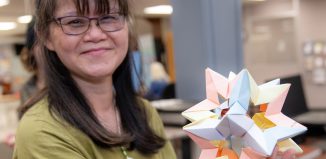How science deals with the unknown
By Elof Carlson
Science explores the unknown. I love the history of science because it reveals how science has changed our way of seeing the universe. It rejects the supernatural as an explanation. This has led to the formation of the major fields of science — physics, astronomy, geology, chemistry and biology.
Combinations of these fields are used to explore other fields like oceanography, meteorology or paleontology. Those sciences require data gathering, associations, experimentation and the invention of instruments to obtain data not detectable with our own senses.
Telescopes, microscopes, centrifuges, cyclotrons, cameras, chromatography, space probes, computers, electronic sensors and hundreds of other devices are used in different fields of science to give us information about other planets, stars and galaxies. These tools allow it to smash atoms, sequence DNA or work out how an organism shifts from a fertilized egg to a crying newborn.
There is another lesson I learned from studying the history of science. We don’t know as much as we think we do. Almost all of modern science from the origin of starlight to the cellular composition of our bodies was unknown before the existence of the right tools and level of understanding of how things worked.
A college science textbook is complete only for the generation of students reading it. It becomes outdated within five years and new texts are required. The new material comes from new tools introduced, new experiments revealing unexpected outcomes and chance findings from sifting through data.
In my own field I would identify as a major unknown the composition and functions of the cytoplasm of the cell. This is the material in which the cell nucleus and membrane-bound organelles are located (the mitochondria, Golgi, endoplasmic reticulum and lysosomes are examples). But the “glop” around them is a gel of sorts and has some cytoskeletal components. What is not known are the component molecules and the structural arrangement of the molecules in the cell cytoplasm that makes it unique to the species.
You cannot put a fertilized mouse cell nucleus in an enucleated egg of a fish or toad or rabbit. That inability may be a consequence of the products of nuclear genes stored in the cytoplasm that are essential for turning genes on or off after fertilization. Lots of experiments will have to be done to see what’s going on.
That is the challenge of science. Each new generation of students looks at things in fresh or original ways. The old way of describing and interpreting things gives way. Sometimes it is rapid, such as the field of molecular biology after the discovery of nucleic acids as the hereditary material.
Often it is slow. The discovery of new organs or tissues in the human body is relatively slow. About once every 20 years or so, I read an article that a new tendon or region of the brain, or some new function of a gland, has been discovered.
No new continents on Earth have been discovered since the polar regions were explored in the late nineteenth and early twentieth centuries. Our technology for photographing Earth makes such a finding virtually impossible. We can predict what we can infer from the known knowledge of our fields, but we cannot predict what is totally unknown to us.
Some seek refuge in such areas of the unknown because they hope to tuck their supernatural beliefs into reality, but it is not reality until that area is fleshed out with data, functions and a comprehension of how things work and can be tested for their predictions and claims.
Elof Axel Carlson is a distinguished teaching professor emeritus in the Department of Biochemistry and Cell Biology at Stony Brook University.






